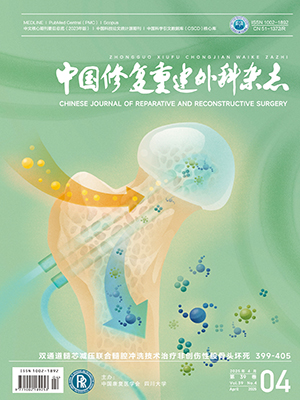| 1. |
Zhao DW, Yu M, Hu K, et al. Prevalence of nontraumatic osteonecrosis of the femoral head and its associated risk factors in the Chinese population: Results from a nationally representative survey. Chin Med J (Engl), 2015, 128(21): 2843-2850.
|
| 2. |
Mont MA, Cherian JJ, Sierra RJ, et al. Nontraumatic osteonecrosis of the femoral head: Where do we stand today? A ten-year update. J Bone Joint Surg (Am), 2015, 97(19): 1604-1627.
|
| 3. |
Pauwels F. The place of osteotomy in the operative management of osteoarthritis of the hip. Triangle, 1968, 8(6): 196-210.
|
| 4. |
Hamanishi M, Yasunaga Y, Yamasaki T, et al. The clinical and radiographic results of intertrochanteric curved varus osteotomy for idiopathic osteonecrosis of the femoral head. Arch Orthop Trauma Surg, 2014, 134(3): 305-310.
|
| 5. |
Yusuke O, Taisuke S, Toshiaki O, et al. Long-term outcomes of curved intertrochanteric varus osteotomy combined with bone impaction grafting for non-traumatic osteonecrosis of the femoral head. Bone Joint J, 2021, 103-B(4): 665-671.
|
| 6. |
Shohat N, Copeliovitch L, Smorgick Y, et al. The long-term outcome after varus derotational osteotomy for Legg-Calvé-Perthes disease: A mean follow-up of 42 years. J Bone Joint Surg (Am), 2016, 98(15): 1277-1285.
|
| 7. |
Ito H, Kaneda K, Matsuno T. Osteonecrosis of the femoral head. Simple varus intertrochanteric osteotomy. J Bone Joint Surg (Br), 1999, 81(6): 969-974.
|
| 8. |
Mont MA, Fairbank AC, Krackow KA, et al. Corrective osteotomy for osteonecrosis of the femoral head. J Bone Joint Surg (Am), 1996, 78(7): 1032-1038.
|
| 9. |
Pavlovcic V, Dolinar D. Intertrochanteric osteotomy for osteonecrosis of the femoral head. Int Orthop, 2002, 26(4): 238-242.
|
| 10. |
郑潮顺, 李春海. 虚拟现实技术在骨科术前规划中的应用. 中国骨科临床与基础研究杂志, 2017, 9(5): 310-315.
|
| 11. |
Bekelis K, Calnan D, Simmons N, et al. Effect of an immersivepreoperative virtual reality experience on patient reportedoutcomes: A randomized controlled trial. Ann Surg, 2017, 265(6): 1068-1073.
|
| 12. |
Inao S, Ando M, Gotoh E, et al. Minimum 10-year results of Sugioka’s osteotomy for femoral head osteonecrosis. Clin Orthop Relat Res, 1999, (368): 141-148.
|
| 13. |
Takashima K, Sakai T, Hamada H, et al. Which classification system is most useful for classifying osteonecrosis of the femoral head? Clin Orthop Relat Res, 2018, 476(6): 1240-1249.
|
| 14. |
李子荣, 刘朝晖, 孙伟, 等. 基于三柱结构的股骨头坏死分型——中日友好医院分型. 中华骨科杂志, 2012, 32(6): 515-520.
|
| 15. |
Sugioka Y. Transtrochanteric anterior rotational osteotomy of the femoral head in the treatment of osteonecrosis affecting the hip: a new osteotomy operation. Clin Orthop Relat Res, 1978, (130): 191-201.
|
| 16. |
周思佳, 姜文学. 基于CJFH分型的股骨头坏死三维分型及塌陷预测. 中国组织工程研究, 2018, 22(19): 3033-3038.
|
| 17. |
Kalhor M, Beck M, Huff TW, et al. Capsular and pericapsular contributions to acetabular and femoral head perfusion. J Bone Joint Surg (Am), 2009, 91(2): 409-418.
|
| 18. |
肖凯, 罗殿中, 程徽, 张振东, 张洪. 股骨颈基底部旋转截骨术治疗早期股骨头坏死的临床疗效. 中华骨科杂志, 2018, 38(7): 425-432.
|
| 19. |
Okura T, Hasegawa Y, Morita D, et al. What factors predict the failure of curved intertrochanteric varus osteotomy for the osteonecrosis of the femoral head? Arch Orthop Trauma Surg, 2016, 136(12): 1647-1655.
|
| 20. |
高润子, 夏天卫, 环大维, 等. 虚拟现实技术辅助下经股骨颈基底部旋转截骨术治疗股骨头坏死11例. 中国中医骨伤科杂志, 2021, 29(5): 51-55.
|




